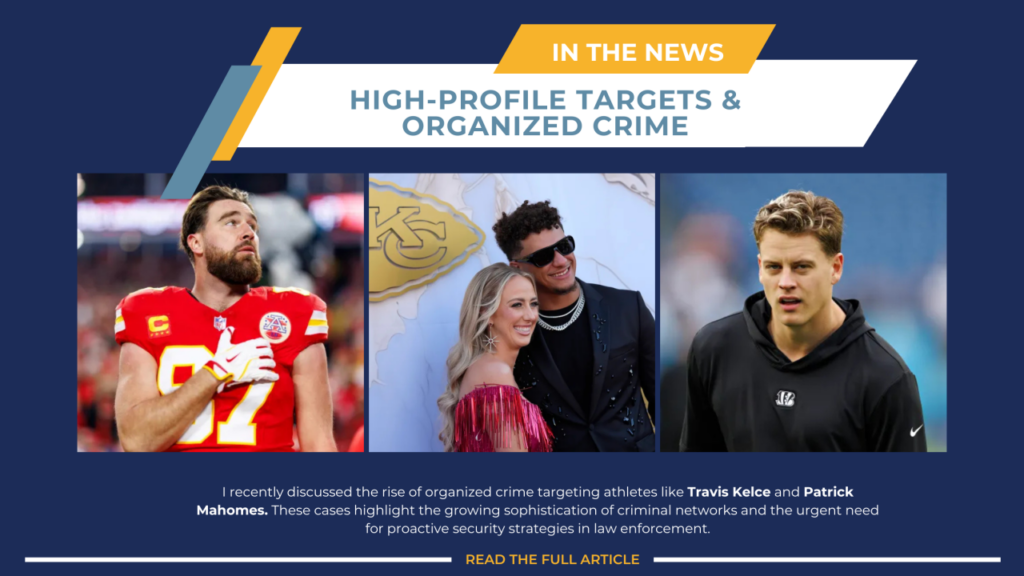
The recent break-ins targeting NFL stars like Travis Kelce, Patrick Mahomes, and Joe Burrow are not isolated incidents—they are part of a larger, more sophisticated criminal trend that law enforcement cannot afford to ignore. These crimes highlight the growing capabilities of organized crime rings that exploit gaps in security with precision and speed. Traditional burglary deterrents are proving ineffective against criminals who plan meticulously, adapt quickly, and execute with alarming efficiency.
The Tactics of Organized Crime Rings
These aren’t random smash-and-grab burglaries. The individuals behind these crimes are highly trained, well-funded, and deeply networked. They use advanced techniques that make them difficult to detect and even harder to stop.
Criminals use signal jammers to disable home security systems and surveillance cameras before a break-in occurs. They track targets using publicly available information—game schedules, social media posts, even satellite imagery—to determine when a home will be empty. They blend in by posing as construction workers, landscapers, or joggers while scouting homes. And when the moment comes, they execute the burglary in under 15 minutes, minimizing the risk of being caught.
These tactics aren’t just effective—they exploit predictable patterns of movement and common security blind spots. Without strategic countermeasures, law enforcement will continue to fall behind.
Why Athletes Are Easy Targets
High-profile individuals, especially professional athletes, present an ideal target for organized crime groups. Their travel schedules are often public, their assets are highly valuable, and their homes are frequently left unoccupied for extended periods.
One of the most significant vulnerabilities is predictability. Game days, road trips, and travel itineraries are widely available, making it easy for criminals to determine when a home will be vacant. Unlike private citizens with irregular routines, professional athletes operate on a fixed calendar, allowing criminals to plan their break-ins with precision.
Beyond scheduling, the high-visibility lifestyle of athletes and celebrities also plays a role. Many frequently showcase their homes, luxury cars, and valuable possessions on social media, unintentionally providing criminals with a virtual blueprint of their assets. What’s meant to celebrate success often becomes an open invitation for criminals who track their targets online.
Then there’s the nature of the assets themselves. Cash, jewelry, rare memorabilia, and high-end designer goods aren’t just valuable—they’re also easy to resell on the black market. Criminals know they can quickly turn stolen goods into profit with minimal risk of detection, making these break-ins even more appealing.
When you combine all of these factors—predictable schedules, highly visible lifestyles, and easily resold luxury items—it’s easy to see why professional athletes are at such high risk. Their wealth and status make them lucrative targets, and without proactive security measures, they remain vulnerable to increasingly sophisticated criminal networks.
A Necessary Shift in Security and Law Enforcement Strategy
This isn’t just a problem for the victims—it’s a failure of law enforcement and the security industry that needs immediate attention. The burden of protection can’t fall solely on individual athletes. Leagues, teams, and law enforcement agencies need to step up.
At the very least, major sports organizations like the NFL and NBA should be doing more to protect their players. They should be offering mandatory security education, so players understand the risks and know how to protect themselves. They should facilitate proactive risk assessments to help players secure their homes against these types of attacks. They should also work more closely with law enforcement to track and prevent these crimes before they happen.
This issue highlights a much bigger problem in policing today—we’re too reactive. Criminals aren’t waiting around for law enforcement to catch up. They’re adapting, evolving, and staying ahead of the game. Law enforcement, security professionals, and organizations that deal with high-profile individuals need to do the same.
This is a central theme in my upcoming book, On Thin Ice, which is all about reimagining policing. If we continue responding to crime after it happens instead of anticipating and preventing it, we will always be one step behind. Crime prevention isn’t just about stronger enforcement—it’s about smarter enforcement. It means taking a more proactive, intelligence-driven approach to public safety. It means working across agencies, using better technology, and shifting from a reactive model to one that prioritizes prevention.
The same principles apply to protecting high-profile individuals. Instead of relying on outdated security measures, we need strategies that anticipate threats before they materialize. If criminals are getting smarter, law enforcement needs to be even smarter.
Practical Security Strategies for Athletes and the Public
While professional athletes are uniquely vulnerable, these same security principles apply to anyone concerned about burglary and personal safety.
Basic steps like upgrading physical security, implementing multi-layered security measures, limiting access to your home, and being mindful of social media use can significantly reduce the risk of becoming a target. Engaging with your local community—having trusted neighbors who can keep an eye on your home while you’re away—adds another layer of protection.
The Bottom Line
Criminal organizations are evolving. Law enforcement must evolve, too. If we continue reacting instead of anticipating, we will always be one step behind.
This isn’t just about protecting athletes—it’s about modernizing security strategies for a world where criminals are more organized, sophisticated, and dangerous than ever before.
🔗 Read more in The U.S. Sun’s exclusive piece.
What steps should law enforcement and security professionals be taking to stay ahead of these evolving threats? Connect with me on social and let me know your thoughts.



